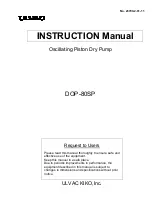
05
Operation
(15) This pump is not designed to be explosion-proof. When using the pump, ensure that there
are no inflammable materials such as solvents, or explosive gases, in the vicinity. Use under
such conditions may result in injury or fire.
(16) Inserting fingers or objects into the motor inlet may result in electric shock, injury, or fire.
(17) There is fear of the explosion. Please do not drive the pump with the exhaust side shut.
Pressure in the pump rises, and the main body of the pump might explode, and the motor
become an overload. The limit value of pump internal pressure is 0.50MPa (gage pressure).
Please install the protection instrument such as safety valves.
Maintenance and Repair
(18) The pump should be dismantled or repaired only by a repair technician trained by the
manufacturer.
(19) To prevent ingestion of microscopic particles resulting from wear of components, use a dust
mask and gloves when replacing cup packing, inlet and outlet valves, and gaskets.
Installation
(1) Microscopic particles resulting from wear of components are discharged from the outlet and
contaminate the room. If necessary, connect a pipe from the discharge outlet to the outside of
the building.
(2) The fine clearances used in this pump require that the following conditions be satisfied during
storage, installation, and operation.
1.
Ambient temperature of 7~40°C and maximum relative humidity of 85% during operation.
2.
Other conditions for storage and operation.
a) Level floor of sufficient strength.
b) No condensation
c) Dust-free environment
d) Well ventilated
e) Environment free of corrosive or explosive gas.
f)
Not subject to direct sunlight.
g) No danger of fire.
h) Maximum ambient temperature of 40°C during assembly of pump.
i) Free of soot and oil.
j) Free of splashing or flooding.
k) Keep it indoor ventilated.
l) When installing the pump, avoid mounting a pump directly on the base. Employ
anti-vibration rubber between the base and the pump.
Operation
(3) Do not use in applications involving organ transplants, or contact with body fluids or living
tissue.
(4) Touching rotating components (eg motor, main shaft, axial joints, cooling fan) while the pump is
in operation may result in injury.
(5) The overload protector operates when the pump becomes excessively hot. Touching it in this
condition may result in burns.
(6) Touching the pump while the pump is in operation or while it is still hot immediately after having
been switched off may result in burns.
(7) Do not insert fingers or objects into, or peer into, the inlet or outlet during operation.
(8) Ensure that the customer installs a trap if steam is generated. Ensure that condensate does not
enter the pump. A malfunction may result if condensate enters the pump.
!
Warning
!
Caution









































